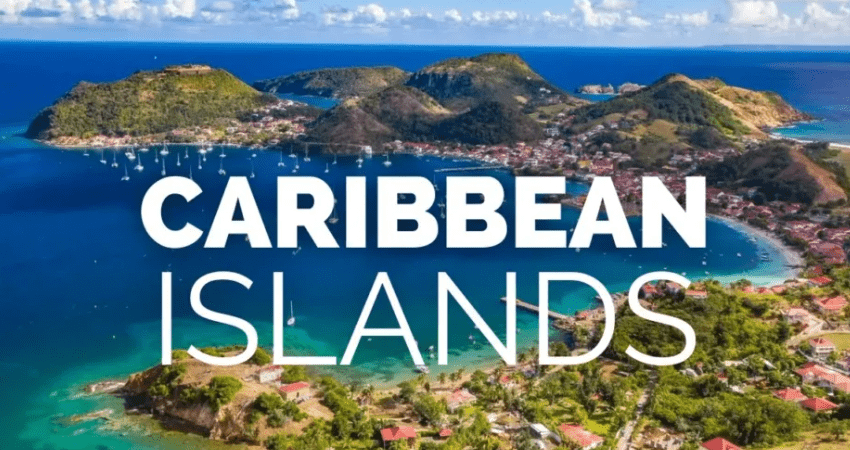
The Caribbean Islands are a diverse and enchanting region, known for their stunning natural beauty, vibrant cultures, and warm hospitality. Comprising more than 7,000 islands, islets, and cays, the Caribbean is a popular destination for travelers seeking sun, sand, and sea. Here’s a description of the Caribbean Islands for travelers:
- Geography:
- The Caribbean Islands are located in the Caribbean Sea, southeast of the Gulf of Mexico and the mainland of North America.
- The islands can be divided into three main regions: the Greater Antilles, Lesser Antilles, and the Bahamas.
- Climate:
- The Caribbean has a tropical climate with warm temperatures year-round. It is characterized by a wet season (June to November) and a dry season (December to May).
- The region is prone to hurricanes during the wet season, so travelers should be aware of the weather conditions when planning their trips.
- Beaches:
- The Caribbean is famous for its pristine white-sand beaches and crystal-clear turquoise waters. Each island offers its unique coastal charm, from secluded coves to lively beachfronts.
- Popular beach destinations include the Bahamas, Turks and Caicos, Aruba, and the Dominican Republic.
- Cultural Diversity:
- The Caribbean is a melting pot of cultures, reflecting the influences of indigenous peoples, European colonizers, African slaves, and more recent migrants.
- Each island has its own distinct culture, music, dance, and cuisine. Visitors can experience the lively rhythms of reggae in Jamaica, the salsa in Cuba, or the calypso in Trinidad and Tobago.
- Water Activities:
- The Caribbean Sea offers a paradise for water enthusiasts. Snorkeling and diving are popular, with vibrant coral reefs teeming with marine life.
- Water sports such as windsurfing, kiteboarding, and sailing are also widely enjoyed. Many resorts and beachfront areas offer equipment rentals and lessons.
- Culinary Delights:
- Caribbean cuisine is a delightful fusion of flavors, blending African, European, and indigenous influences.
- Visitors can savor local dishes like jerk chicken in Jamaica, conch fritters in the Bahamas, or roti in Trinidad. Fresh seafood, tropical fruits, and spices are staples in Caribbean cooking.
- Historical Sites:
- The Caribbean has a rich history, with colonial-era architecture and historical sites to explore. Old San Juan in Puerto Rico, Havana in Cuba, and Willemstad in Curaçao are notable examples.
- Some islands were once important hubs in the transatlantic slave trade, and there are museums and memorials dedicated to this aspect of Caribbean history.
- Adventure and Nature:
- Beyond the beaches, the Caribbean offers lush rainforests, waterfalls, and volcanic landscapes. Hiking, zip-lining, and eco-tours provide opportunities to explore the natural beauty of the islands.
- National parks and nature reserves, such as El Yunque in Puerto Rico or the Baths in Virgin Gorda, offer stunning scenery and outdoor adventures.
- Festivals and Events:
- The Caribbean is known for its vibrant festivals and events, celebrating everything from music and dance to food and religious traditions.
- Carnival is a highlight in many islands, featuring colorful parades, elaborate costumes, and lively music. Trinidad and Tobago’s Carnival is one of the most famous in the region.
- Hospitality and Warmth:
- One of the defining characteristics of the Caribbean is the warmth and friendliness of its people. Visitors often find a welcoming atmosphere and a laid-back, relaxed pace of life.
Whether you’re seeking relaxation on the beach, cultural immersion, or adventurous activities, the Caribbean Islands offer a diverse range of experiences for travelers. Each island has its own unique charm, making it a destination that caters to a wide range of interests and preferences.
The best time to visit the Caribbean Islands depends on your preferences and the specific activities you plan to engage in. Generally, the Caribbean has a tropical climate with two main seasons: the dry season (December to April) and the wet season (June to November). Here are some considerations for each season:
Best time to visit Caribbean Islands
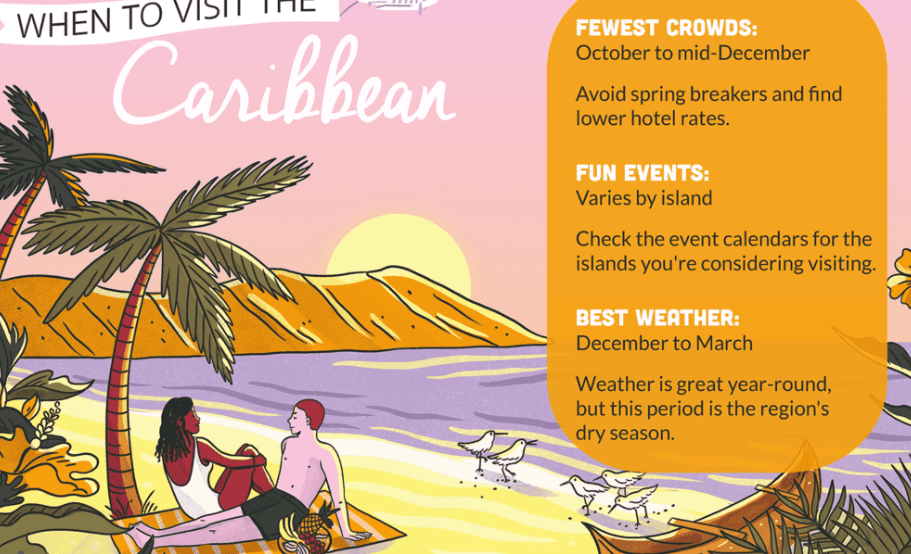
- Dry Season (December to April):
- Weather: This is the peak tourist season, characterized by dry and relatively cooler weather. There is minimal rainfall during these months.
- Activities: Ideal for beach vacations, water sports, and outdoor activities.
- Wet Season (June to November):
- Weather: This period coincides with the hurricane season. While not every location in the Caribbean is affected by hurricanes, there is an increased risk of rain and storms. August and September are typically the peak months for hurricanes.
- Activities: Prices may be lower during the wet season, and the islands are less crowded. However, some activities and excursions may be limited due to weather conditions.
- Shoulder Seasons (May and late November):
- Weather: These months can offer a good compromise between the dry and wet seasons. The weather is often pleasant, and the risk of hurricanes is lower.
- Activities: You may find fewer crowds and lower prices during these shoulder seasons.
Keep in mind that specific weather patterns can vary between islands, so it’s essential to check the climate of the particular island you plan to visit. Additionally, if you’re concerned about hurricanes, consider purchasing travel insurance that covers trip interruptions due to weather.
Ultimately, the best time to visit the Caribbean depends on your priorities—whether you prioritize dry weather, lower prices, or a balance between the two.
To travel to a Caribbean island, you’ll typically start by researching and booking flights, accommodations, and possibly transportation within the destination. Here are some general steps and sources to consider:
Travel Source to visit Caribbean island
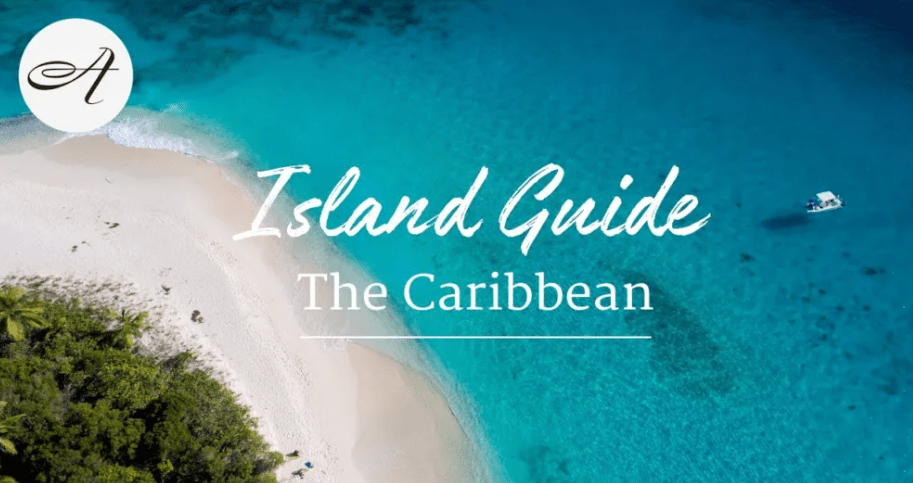
- Flight Booking:
- Online Travel Agencies (OTAs): Websites like Expedia, Kayak, Skyscanner, and Google Flights allow you to compare prices from various airlines.
- Airline Websites: Directly check the websites of major airlines or regional carriers that operate in the Caribbean.
- Accommodation:
- Hotel Booking Websites: Platforms like Booking.com, Hotels.com, and Airbnb can help you find a variety of accommodations.
- Resort Websites: If you’re interested in resorts, check the specific websites of popular resorts in the Caribbean.
- Transportation:
- Car Rentals: If you need a car, websites such as Hertz, Avis, or local car rental agencies can be useful.
- Public Transportation: Research local transportation options at your destination, such as buses or taxis.
- Travel Packages:
- Travel Agencies: Consider contacting travel agencies that specialize in Caribbean destinations. They may offer package deals that include flights, accommodations, and sometimes activities.
- Travel Guides and Reviews:
- Travel Blogs: Read travel blogs for personal experiences and tips. Bloggers often share valuable insights and recommendations.
- Review Websites: Check reviews on platforms like TripAdvisor to get an idea of popular attractions, restaurants, and activities.
- Travel Insurance:
- Insurance Providers: Research and purchase travel insurance from reputable providers to cover unexpected events during your trip.
- Local Tourism Websites:
- Official Tourism Websites: Visit the official tourism websites of the specific Caribbean island you plan to visit. These sites often provide valuable information on attractions, events, and local services.
- Visa and Entry Requirements:
- Embassy or Consulate: Check with the embassy or consulate of the Caribbean island you’re visiting to understand visa requirements and entry regulations.
- Health Precautions:
- CDC or WHO: Stay informed about health-related travel advisories and requirements by checking the websites of the Centers for Disease Control and Prevention (CDC) or the World Health Organization (WHO).
Always make sure to plan well in advance, especially when it comes to booking flights and accommodations, to secure the best prices and availability. Additionally, keep an eye on travel advisories and entry requirements, as these can change.
Currency details of Caribbean island

The Caribbean is a region that consists of the Caribbean Sea and its islands. It’s important to note that the currencies used in Caribbean islands can vary, as there are many different countries and territories in the region. Here are some examples:
- Eastern Caribbean Dollar (XCD): This is the official currency of eight Eastern Caribbean countries, including Antigua and Barbuda, Dominica, Grenada, Saint Kitts and Nevis, Saint Lucia, Saint Vincent and the Grenadines, Anguilla, and Montserrat.
- Bahamian Dollar (BSD): The Bahamas use the Bahamian Dollar as their official currency.
- Barbadian Dollar (BBD): Barbados uses the Barbadian Dollar.
- Cayman Islands Dollar (KYD): The Cayman Islands use their own currency, the Cayman Islands Dollar.
- Jamaican Dollar (JMD): Jamaica uses the Jamaican Dollar.
- Trinidad and Tobago Dollar (TTD): Trinidad and Tobago use the Trinidad and Tobago Dollar.
- Aruban Florin (AWG): Aruba uses the Aruban Florin.
- Netherlands Antillean Guilder (ANG): The Netherlands Antilles, which includes Curaçao and Sint Maarten, use the Netherlands Antillean Guilder.
- Haitian Gourde (HTG): Haiti uses the Haitian Gourde.
- Dominican Peso (DOP): The Dominican Republic uses the Dominican Peso.
- Cuban Peso (CUP) and Cuban Convertible Peso (CUC): Cuba has a dual currency system with the Cuban Peso (CUP) used by locals and the Cuban Convertible Peso (CUC) used mainly by tourists. However, the Cuban government has been taking steps to unify these currencies.
It’s important to verify the current exchange rates and currency details, as they can change. Additionally, some territories may use the currency of the country to which they are politically affiliated.
Options for stay in Caribbean islands
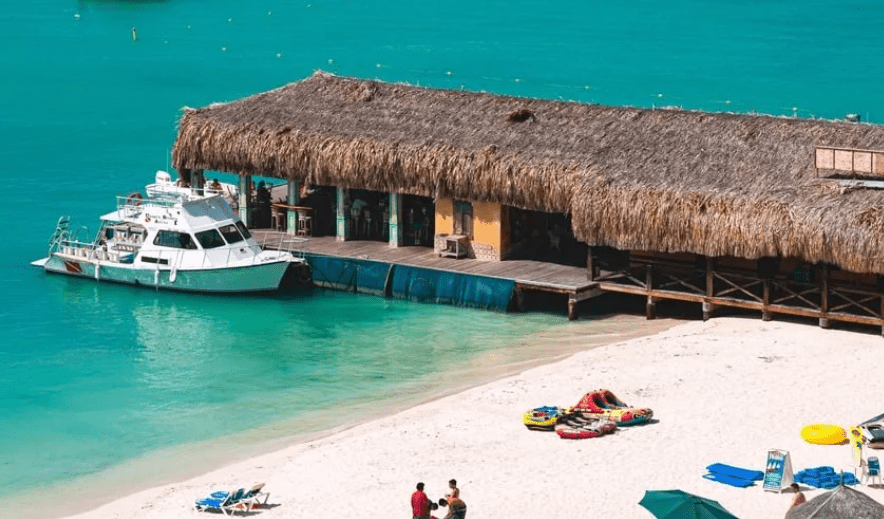
The Caribbean islands offer a wide range of options for accommodation, from luxury resorts to budget-friendly hotels, boutique inns, and vacation rentals. Here are some popular options for a stay in the Caribbean:
- All-Inclusive Resorts:
- Many Caribbean islands are known for their all-inclusive resorts, where you pay a flat fee that includes accommodation, meals, drinks, and sometimes even activities. This can be a convenient option for those who want to relax without worrying about additional expenses.
- Luxury Resorts:
- The Caribbean is home to numerous luxury resorts, often located on private islands or secluded beaches. These resorts typically offer high-end amenities, spa services, fine dining, and personalized service.
- Boutique Hotels:
- Some travelers prefer smaller, boutique hotels for a more intimate and unique experience. These properties often showcase local architecture and culture and provide a personalized touch to their services.
- Vacation Rentals:
- Platforms like Airbnb and Vrbo offer a variety of vacation rentals, including apartments, villas, and houses. This option can be suitable for those looking for more independence, especially for longer stays or for travelers who prefer a home-like environment.
- Guesthouses and Inns:
- Many Caribbean islands have charming guesthouses and inns that provide a more local and authentic experience. These accommodations are often smaller and family-run, offering a chance to interact with locals and immerse yourself in the culture.
- Eco-Friendly and Sustainable Accommodations:
- With a growing focus on sustainability, some travelers may prefer eco-friendly resorts or hotels that prioritize environmentally friendly practices. These accommodations often strive to minimize their impact on the local ecosystem.
- Cruise Ships:
- Cruises are another popular way to experience the Caribbean, allowing you to visit multiple islands in one trip. Many cruise lines offer a range of itineraries, from short weekend getaways to longer voyages.
- Glamping:
- Some Caribbean destinations offer glamping (glamorous camping) options, combining the experience of camping with luxury amenities. This can be a unique way to connect with nature without sacrificing comfort.
When choosing accommodation, consider your budget, preferred level of luxury, the type of experience you want, and the specific activities and attractions you plan to explore on the island. Each Caribbean island has its own unique charm and offerings, so you can tailor your stay to match your preferences.
Food options in Caribbean Islands
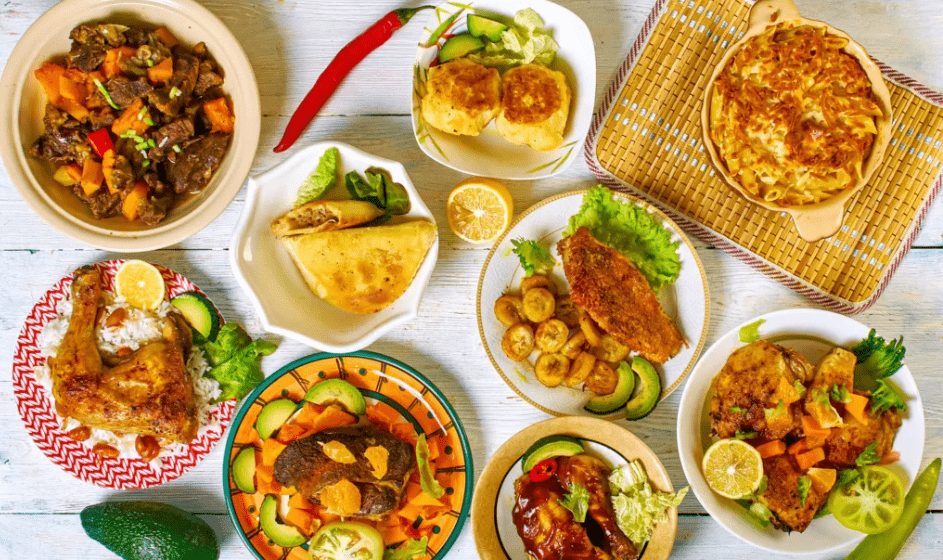
The Caribbean Islands are known for their rich and diverse culinary traditions, influenced by African, European, Indigenous, and Asian cultures. Each island has its own unique dishes and flavors, but there are some common elements across the region. Here are some popular food options you might find in the Caribbean:
- Jerk Chicken/Pork: A well-known Jamaican dish, jerk seasoning consists of a flavorful blend of spices like scallion, thyme, allspice, and Scotch bonnet peppers. The meat is marinated and then slow-cooked or grilled, resulting in a spicy and smoky flavor.
- Roti: This Indian-influenced dish is popular in Trinidad and Tobago, as well as other islands. It consists of unleavened flatbread filled with curried meat (often chicken, goat, or beef), potatoes, and chickpeas.
- Ackee and Saltfish: The national dish of Jamaica, ackee is a fruit that is cooked with salted codfish, onions, tomatoes, and spices. It’s often served with fried dumplings or breadfruit.
- Conch Fritters: Conch, a type of sea snail, is often used in Caribbean cuisine. Conch fritters are a popular appetizer, where diced conch is mixed with batter and deep-fried.
- Callaloo: A leafy green vegetable similar to spinach, callaloo is often used in Caribbean soups and stews. It can also be prepared as a side dish sautéed with onions, garlic, and other seasonings.
- Rice and Peas: A staple in many Caribbean countries, rice and peas is made with rice cooked in coconut milk and seasoned with thyme, scallion, and sometimes kidney beans or pigeon peas.
- Fish Escovitch: This dish involves frying fish and then topping it with a spicy pickled vegetable sauce made from carrots, onions, and bell peppers.
- Coco Bread and Patty: In Jamaica, coco bread is a soft and slightly sweet bread often used to make sandwiches with a spicy meat patty inside. The patty can be filled with beef, chicken, or vegetable curry.
- Festival: A sweet fried dough often served alongside jerk dishes in Jamaica.
- Pepper Pot Soup: A hearty soup made with callaloo, okra, pepper pot (a leafy vegetable), and sometimes meat.
- Doubles: Originating from Trinidad and Tobago, doubles are a popular street food made with two flatbreads filled with curried chickpeas.
These are just a few examples, and the cuisine can vary significantly from island to island. The use of fresh, tropical ingredients and a blend of cultural influences make Caribbean food vibrant and flavorful.
Travel Guide to visit Caribbean Islands
Visiting the Caribbean Islands can be an exciting and unforgettable experience, given the region’s stunning landscapes, vibrant cultures, and beautiful beaches. Here’s a general travel guide to help you plan your trip to the Caribbean:
1. Choosing the Right Island:
- Consider Your Interests: Each Caribbean island has its own unique charm and offerings. Some are known for their beaches, while others boast lush rainforests or vibrant cultural scenes.
- Budget: Prices can vary significantly from one island to another. Consider your budget for accommodation, meals, and activities.
2. Best Time to Visit:
- Peak Season: The high season is from December to April when the weather is dry and temperatures are warm. However, this is also the most expensive time to visit.
- Off-peak Season: May to November is the hurricane season, but this is also when prices are lower. Just be aware of the weather and potential for storms.
3. Travel Documents:
- Passport and Visa: Ensure your passport is valid for at least six months beyond your planned departure date. Check visa requirements for the specific country you’re visiting.
4. Health and Safety:
- Vaccinations: Check if any vaccinations are required or recommended for the specific islands you plan to visit.
- Health Insurance: Make sure your travel insurance covers medical emergencies.
5. Transportation:
- Flights: Research and book flights well in advance for better deals.
- Inter-island Travel: Depending on your itinerary, you might need to book additional flights or ferry rides between islands.
6. Accommodation:
- Resorts: Many visitors opt for all-inclusive resorts, which can offer great value for money.
- Hotels and Villas: There are also boutique hotels and rental villas available for those seeking a more local experience.
7. Local Transportation:
- Car Rentals: Consider renting a car for more freedom in exploring the islands.
- Public Transport: Many islands have public transportation, such as buses and taxis.
8. Currency:
- Check the Local Currency: Although many places accept major credit cards, it’s a good idea to have some local currency on hand.
9. Activities:
- Water Sports: Snorkeling, scuba diving, and water skiing are popular activities.
- Cultural Events: Check for local festivals and events happening during your visit.
10. Respect Local Culture:
- Dress Code: Respect local customs, especially if visiting religious sites.
- Language: English is widely spoken, but knowing a few local phrases can be appreciated.
11. Weather Awareness:
- Hurricane Preparedness: If visiting during hurricane season, stay updated on weather forecasts and follow any advisories.
12. Packing Tips:
- Sun Protection: Pack sunscreen, hats, and sunglasses.
- Light Clothing: The climate is generally warm, so pack lightweight and breathable clothing.
13. Emergency Contacts:
- Know Local Emergency Numbers: Be aware of the emergency contact numbers for the country you are visiting.
14. Connectivity:
- SIM Cards: Consider purchasing a local SIM card for your phone for cost-effective communication.
15. Environmental Responsibility:
- Respect Nature: Many Caribbean islands have delicate ecosystems, so follow responsible tourism practices.
Remember that each Caribbean island is unique, so tailor your plans to the specific destination you choose. Research and planning are key to ensuring a smooth and enjoyable trip to the Caribbean.
